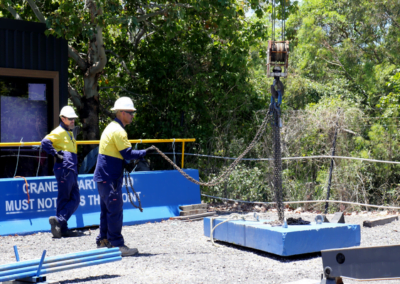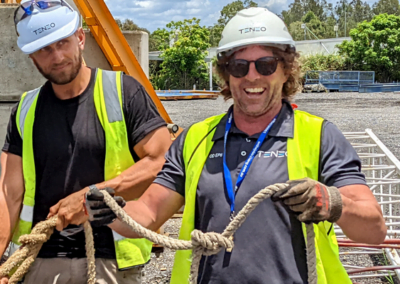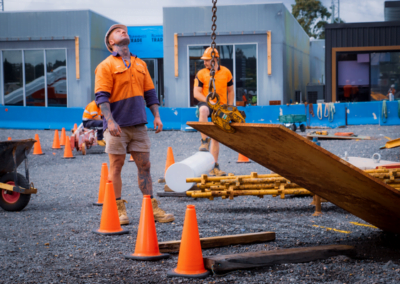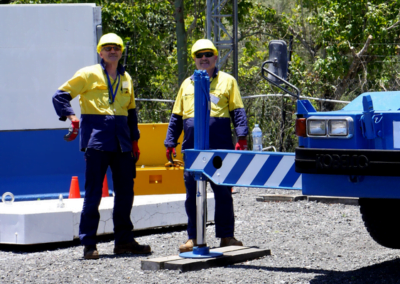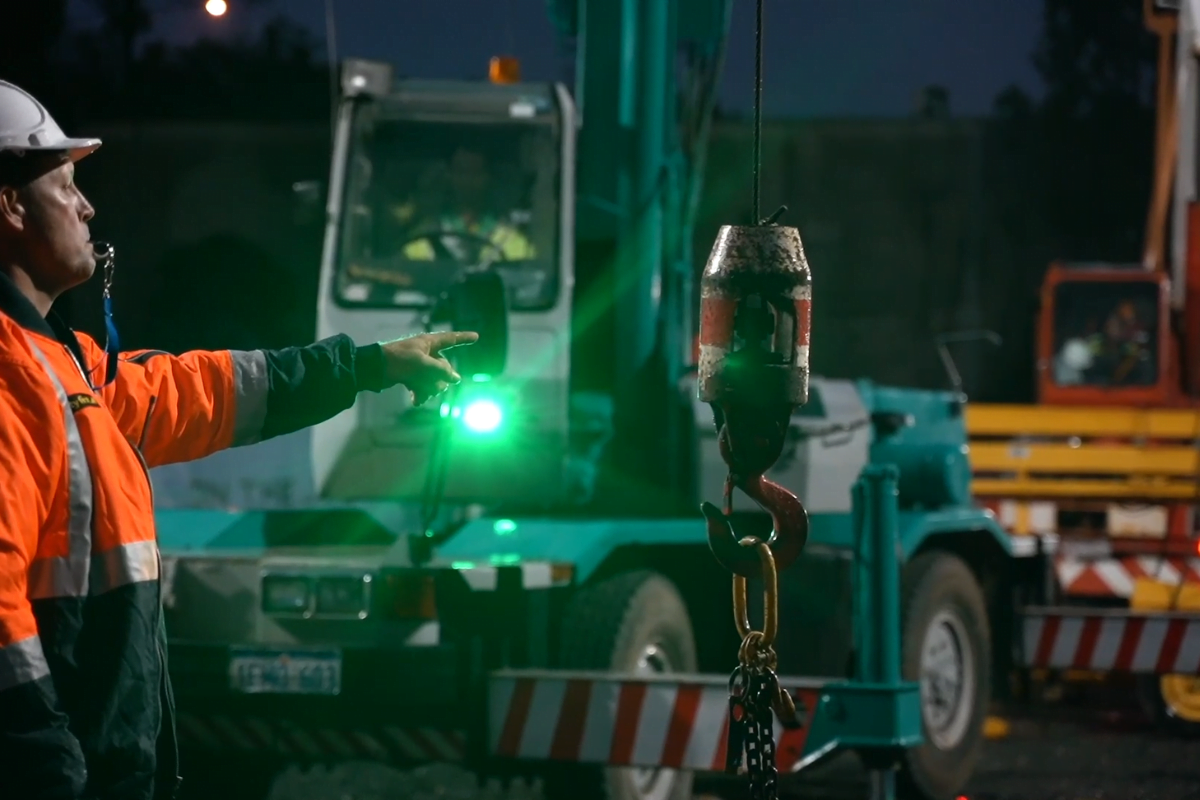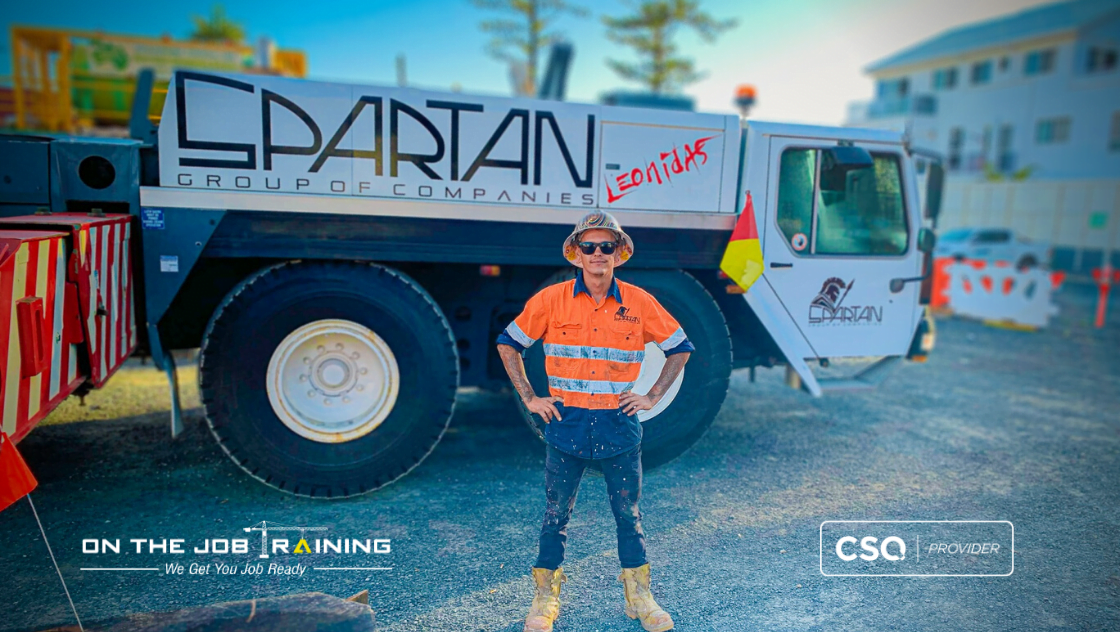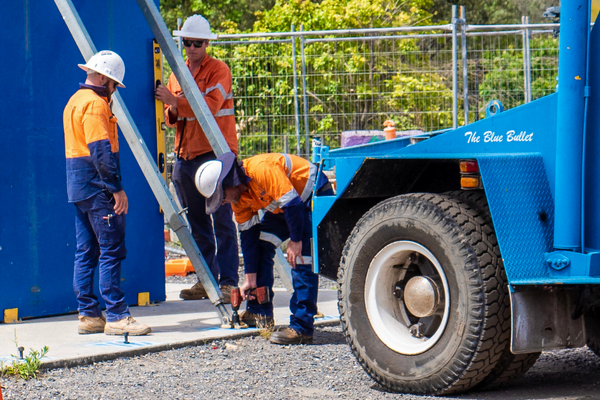How to Become a Dogman
Employment & Careers | 5 Minute Read
Written by Jimmi Nolan
Join our mailing list for 10% off your next course Subscribe
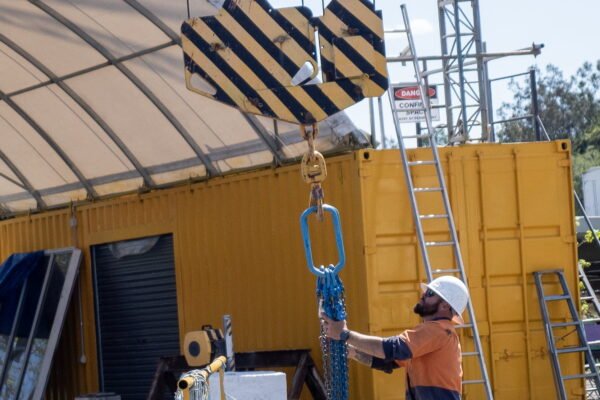
Ever thought about how to become a dogman in Australia and what it takes? If so, you’ve come to the right place!
A dogman plays an important role particularly in construction projects, especially around the safe movement of heavy loads. Learning how to become a dogman could potentially open up lots of new opportunities for you. Not to be confused with someone that trains dogs or enjoys a bit of public voyeurism in their spare time!
Particularly if you want to change roles or get into the construction industry, there’s never been more demand. With record construction project pipelines in Australia but a shortage of skilled workers.
Read on for information about how to become a dogman, earning your dogging ticket and getting hired as one!
1. What is a dogman and what do they do
Dogmen work with crane operators and specialise in slinging loads. Doggers, as they’re also referred to, carry out tasks involving the lifting of items of varying weights, dimensions and materials with a crane.
Dogger duties include reading and interpreting lift plans; determining the safest routes for the lift, avoiding all obstructions along the way. They’re responsible for that load at all times with safety as their number one priority.
Doggers also select and maintain rigging equipment, as well as being constantly aware of their surroundings, both inside and outside the crane operating vicinity. In Australia, any decision that needs to be made in movement or slinging of a load with a crane, requires a qualified dogman with a dogging ticket. Aka a DG class high risk work licence.
2. The benefits of becoming a dogman
There are plenty of good reasons to become a qualified dogman – from safety and legal reasons, to job opportunities and earning potential. Having the peace of mind of knowing what you’re doing not only gives you confidence but ensures your safety and those around you. Dogging work is classified as skilled labour so typically earn more per hour than unskilled labouring for example. When good technique is applied, it’s far less taxing on the body too than general labour duties on site and suits a range of ages from young people to seasoned pros. (Please note: you must be 18 years or over to obtain a DG licence in Australia)
If you’re thinking about getting into construction or are already working in the industry, getting your Dogging ticket is a great way to improve your prospects. It also crosses into sectors outside of construction as well, such as transport, mining and other heavy industries.
Read More: 6 Reasons you Need a Dogging Ticket
3. How to become a certified dogman
Dogging is an exciting and fulfilling job, but it requires accreditation. To become a qualified Dogman or Dogger in Australia – you’ll need to undertake a Nationally Recognised Training course. Then, upon successful theoretical and practical assessment of that course (or unit of competency as it’s known), you’ll be able to apply for a Dogging Class High Risk Work Licence (DG).
This allows Dogmen to safely direct crane operations with the necessary skills and knowledge. Which means, you’ll be trained and qualified dogger!
WATCH: Practical dogging training with multiple lifting stations
4. What training specifically as a dogman entails
There are different accredited courses you can take to become a skilled Dogamn. The most comprehensive unit of competency in Australia is ‘Licence to Perform Dogging’. (Course code CPCCLDG3001). This 5 day course, unlike others can lead to a licenced outcome. It includes theoretical and practical training. It will require you to complete a portfolio of work to be deemed competent in that unit. These courses are offered by Registered Training Organisations.
Ok, now you’re competent in Dogging, what next?
Upon being deemed competent by the trainer, you can continue to be officially assessed by a qualified assessor. This includes a closed book exam and a series of 5 lifts in a controlled environment. Following a successful assessment, you will then be invited by the relevant government safety authority in your state (such as Workplace Health & Safety Queensland or SafeWork NSW) to apply for a DG class high risk work licence.
The exam tests your knowledge about all aspects of dogging work safety and communication with operators and other workers. It also includes maths calculations such as accurately determining the weight of load and appropriate slinging configurations to lift it.
You then apply that theory to the practical assessments. You’re required to demonstrate learned skills including inspecting and selection of lifting gear, identifying hazards, tying hitches, and slinging techniques. You’ll also need to direct a load with hand and whistle signals. You’ll need to conduct successful lifts, movements and placements of 5 different loads.
Sounds like a lot right?!
Well, I guess it is but for good reason due to the high risk nature of the work. Australia has a reputation for the strictest of standards when it comes to safety. Which can only be a good thing when there’s so much at risk on a construction site.
If you train at a reputable RTO, then they support all students with training resources. Highly experienced trainers give plenty of practical training so you gain the confidence to pass your assessments.
Some RTO’s offer night dogging courses
5. How to choose an RTO
If you live in an Australian city then you are likely to have a choice of RTO’s to enrol in a course. But how do you choose the right one?
Like most things – do some research! First of all, you need to find an RTO that specialises in high risk work training. Do a Google search to see what comes up near you. Search for things like ‘dogging ticket’ or ‘dogging course’. Usually a Google Map will pop up with each RTO’s location. You can click on the website of a few to get a feel for their training yard, their trainers and if ex-students have left them some good reviews.
You can also check out their prices too. Bear in mind that as with lots of things in life, you get what you pay for. Quality of learning delivery and experience is no different. Having ample machinery available to train on, with small groups and access to trainers and learning resources is an important factor in confidence to pass your assessments. Then, leave the course with the ability to turn your new skills into practise.
6. How to find work as a dogman
Thinking about finding work as a dogger in construction specifically, there’s never been a better time to find yourself in an ideal role. The construction pipeline in Queensland and throughout Australia, particularly in infrastructure projects are at a record high. Analysts predict it will be into the next decade at least.
In south east Queensland, some examples are the light rail extension on the Gold Coast to Burleigh Heads, then onto Coolangatta. Or the Coomera Connector, the parallel motorway to the M1 from Nerang Broadbeach Rd to the Logan Motorway. Then there’s the Brisbane Olympics 2032 projects including 6 new venues to be built.
You may have heard about the renewable energy projects happening throughout Queensland. These are mainly outside of the SEQ corridor in regional Queensland, with the majority in the north. The recent CSQ Renewables report predicts it could lead to as much as $31.5 billion in capital investment from 2022- 2050 in this sector alone.
Therefore, construction workers are, and will remain for the next 3 decades, in huge demand.
Start by registering your details and resumes on recruitment sites. These are designed to help both employers and employees connect to meet their mutual needs.
You could also contact labour hire companies that send workers from their lists to the construction industry. They often work as subcontractors with day or hourly rates.
Finally, try reaching out directly to construction companies – many of them have job postings for roles such as dogman positions.
The more tickets you have – the more attractive you are to employers.
If you’re thinking of getting into the construction industry, or are already working in it, then getting your Dogman ticket is a great way to improve your prospects. Relevant certifications including a dogging ticket with references that could make it easier for them to onboard you over someone that doesn’t.
Having some other handy tickets like:
- Prepare to work safely in the construction industry (aka a ‘white card’, you won’t get on a construction site without one),
- Working Safely at Heights
- Operate an Elevating Work Platform (aka EWP)
These are often an expectation of employers as well so think about doing these short 1 days courses too.
Our final bit of advice is to talk to your trainer or management team at the RTO you get your dogging ticket. Employers are often asking for recommendations from their ex-students looking for talent to join their team.
Check our some examples of Dogging Training at On the Job Training, an RTO halfway from Brisbane to the Gold Coast
7. Tips for working as a successful dogman
Whether you’re just starting out or you’ve been in the game for years, safety should always be your number one priority. Communication with other workers is key; being able to brief them on control measures while continually monitoring for hazards as and when they arise.
Correct slinging techniques and being clear with instructions can help maintain safety and efficiency on the worksite. Planning ahead of time with your crane operator and agreeing lift plans. Giving regular precise updates during a lift such as where the load needs to go/be picked up. The required boom radius or the weight of the load are all helpful instructions over two way radio.
On a construction site, time is money…
So if you want to get hired on a job again, you’ll need to be as efficient as possible. Ultimately, the more you lift in a day (safely!), the happier the site supervisor will be. Thinking ahead about what lifting gear will be needed and making sure they are close at hand. Also, thinking about the next lift (and the one after that) – will not only aid efficiency but reduce fatigue and stress. ‘Back loading’ on a high rise job for instance, so ensuring something’s alway on the hook – lift a load up, bring another load down.
Always be looking for something to do during downtimes too. If you’re sitting around on your phone doing nothing outside smoko or lunchtime site supervisors will notice!
As a Dogman, you also need to wear a few hats…and not just a hard hat!
When it comes to lift schedule management, you need to be easy going but assertive, work well with the tradies but stick to the lift schedule set out by the site supervisor. Everyone has a job to do on site and quite often tradies can get impatient while they wait for the materials to be delivered where they need them. It’s a balancing act and can be hard to please everyone.
And lastly, you need to be qualified!
It takes dedication, skill, communication and safety smarts to be a successful dogman but the lifting game is truly a worthwhile pursuit! Get your dogging ticket and start or continue your career with confidence.
As the British say, working as a dogman is the ‘dogs bollocks’!
Keep these tips in mind, stay safe and confident and be sure to get your dogging ticket by training with a reputable RTO. Dogging can be the beginning of your journey, with popular pathways to pursue more advanced courses from basic to advanced levels of rigging or tower/mobile crane operating. Read more about the differences between dogging and rigging here.
WE OFFER WEEKLY DOGGING COURSES AND ALL LEVELS OF RIGGING
ADDITIONAL DOGGING & RIGGING Content
Tower Crane Dream: How a Bricklayer Became a Dogman
Dogging and Rigging : A Beginner’s Guide
Contact Us
Contact us any time using the details below. Alternatively, leave us a message using the enquiry form we will get back to you the following business day at the latest.
Phone: 07 3807 6061
Email: admin@onthejobtraining.edu.au
Address: 79 Christensen Road, Stapylton QLD 4207
Usual Business Hours: Mon - Fri 6.30AM - 5:00PM

